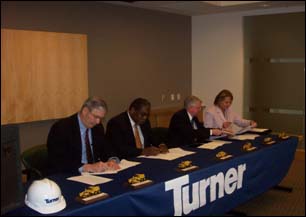Nationwide Children's Replacement Hospital Partnership Promotes Safety and Health on the Worksite

Key signatories signing the Nationwide Children's Replacement Hospital OSP (May 12, 2008)
Background:
Although less than seven percent of American workers makeup the construction industry, approximately 20 percent of all workplace fatalities that occur every year stem from this industry. To help reduce this statistic, Nationwide Children's Hospital, Turner Construction Company, the State of Ohio Bureau of Workers Compensation (BWC) On-Site Consultation Services formed a three-year OSHA Strategic Partnership (OSP) in May 2008. The main purpose of the OSP is to promote safety and health during the Nationwide Children's Replacement Hospital construction project by reducing and eliminating the top four hazards (falls, struck-by, electrocution, and caught-in-between/trenching) associated with injuries and illnesses in construction. The expansion will add more than one million square feet of clinical and research space to the existing two million square-foot hospital with the expected project completion date being 2011. When completed, Nationwide Children's Hospital will be the second largest pediatric hospital and research center in the country.
Success Impact:
Safety and Health Culture Promoted through Increased Training, Recognition, and Self-Inspections
One of the main purposes of the OSP is to promote a safe work environment during the hospital expansion project. One of the strategies for achieving this was to offer and deliver consistent safety training to labor and management. During the first year of the OSP, 24 safety training sessions and over 1,200 hours tailored to the various stages of construction were delivered to 700 employees and managers. To further support the training initiative, contractor safety orientations were conducted every two days on the worksite. All employees who completed the orientation received a hard hat sticker with a control number which were required to be worn at all times. Failure to display the sticker resulted in being asked to leave the worksite.
As required by the OSP, monthly meetings (facilitated by Turner and the OSHA Compliance Assistance Specialist), are held with all participants to help foster communication and relationship building. During these meetings, results of conducted self-inspections are reported out by the site safety specialist. The data obtained from these self-inspections allows for tracking and trending of hazards by type, contractor, and resolution. All findings are then presented to promote open communication and dialogue about specific safety concerns.
Over 120 self-inspections were performed during the first year of the OSP which resulted in over 200 hazards being identified and corrected/abated. This was made possible in part by two comprehensive walkthroughs conducted by the OSHA On-site Consultation Program. Throughout the process, Columbus Office representatives provided technical assistance regarding compliance in areas such as fall protection, electrical hazards, crane safety, and trenching safety which enabled the OSP to conduct more comprehensive self-inspections.
Days Away, Restricted, and Transferred (DART) Rate below Bureau of Labor Statistics' (BLS) National Average for Construction
Also during the first year of the project, the OSP attained a DART rate that was 43 percent below the 2007 BLS national average for the construction industry. The table below presents the OSP's DART rate compared to the 2007 BLS national average for construction during the first ten and a half months of the OSP:
|
Year |
Hours |
# of DART Cases |
DART Rate |
|---|---|---|---|
| OSP Year 1 (8/15/2008 - 6/30/2009) |
121,135 |
1 |
1.6 |
| BLS Industry National Average (2007) |
|
|
2.8 |
| Total Percentage Difference |
|
|
-43% below BLS |
Besides a reduced DART rate, additional benefits experienced by the OSP include: an increased safety and health awareness on the worksite, and improved relationships between labor, management, and OSHA.
Partnership Objectives:
Key objectives of the OSP include: providing a safe and healthful work environment for all employees involved in the construction industry and helping prevent serious accidents and fatalities through increased safety and health training, implementation of best practices, enhanced safety and health management systems, and compliance with applicable OSHA standards and regulation.


